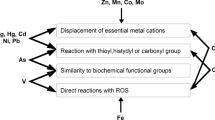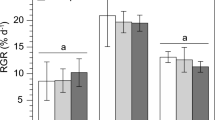Abstract
A comparison of the response of freshwater alga Chlorella vulgaris Beijer. on a quantitatively identical change in tonicity of growth medium by different osmotics (NaCl and sucrose) has been studied. Upon an increase in growth-medium osmotic potential (regardless the nature of osmoticum), increased thermogenesis and decreased oxygen absorption by Chlorella is observed first. The difference in the reaction of Chlorella to equiosmotic concentrations of NaCl and sucrose is revealed. Upon an increased salt background, thermogenesis and photosynthetic activity decreases in comparison with the control and the respiration rate is close to the control. In the presence of sucrose, the culture has a higher level of thermogenesis, respiration, and photosynthesis. Sodium chloride does not cause significant changes in ultrastructure of Chlorella and does not lead to significant changes in the diffusional decay of water magnetization in comparison with the control. Under sucrose stress, a change in the cell shape indicating cytorhysis is revealed. The effective water-diffusion coefficient (according to NMR data) decreases, which also indicates the reduction of cell sizes. Sucrose affects Chlorella as a nonpenetrating osmotically active substance. Under moderate hyperosmotic stress, the toxicity of NaCl is a smaller problem for freshwater microalga Chlorella than the partial dehydration caused by sucrose.






Similar content being viewed by others
REFERENCES
Alekhina, N.D., Balnokin, Yu.V., Gavrilenko, V.F., et al., Fiziologiya rastenii (Plant Physiology), Moscow: Akademiya, 2005.
Almeida, H.N., Calixto, G.Q., Chagas, B.M.E., et al., Characterization and pyrolysis of Chlorella vulgaris and Arthrospira platensis: potential of bio-oil and chemical production by Py-GC/MS analysis, Environ. Sci. Pollut. Res Int., 2017. https://doi.org/10.1007/s11356-017-9009-2
Alyabyev, A.Ju., Loseva, N.L., Gordon, L.Kh., et al., The effect of changes in salinity on the energy yielding processes of Chlorella vulgaris and Dunaliella maritima cells, Thermochim. Acta, 2007, vol. 458, p. 65.
Alyabyev, A., Andreyeva, I., and Rachimova, G., Influence of ph shift and salting on the energetics of microalgae Chlorella vulgaris and Dunaliella maritima,J. Therm. Anal. Calorim., 2011, vol. 104, p. 201.
Andreeva, V.M., Rod Chlorella (Genus Chlorella), Leningrad: Nauka, 1975.
Anisimov, A.V. and Ratkovich, S., Transport vody v rasteniyakh. Issledovanie impul’snym metodom YaMR (Water Transport in Plants: Study by Pulsed NMR), Moscow: Nauka, 1992.
Anisimov, A.V., Ionenko, I.F., and Romanov, A.V., Spin-echo NMR study of the translational water diffusion selectively along the apoplast and the cytoplasmic and vacuolar symplasts of plants, Biophysics (Moscow), 2004, vol. 49, no. 5, p. 816.
Avilov, I.A., Use of various carbon sources by algae of the genus Chlorella in the dark, Vestn. Leningr. Gos. Univ.,Ser. Biol., 1963, vol. 15, no. 3, p. 62.
Balnokin, Yu.V., Ionic homeostasis and osmoregulation in halotolerant microalgae, Fiziol. Rast., 1993, vol. 40, no. 4, p. 567.
Balnokin, Yu.V., Strogonov, B.P., Kukaeva, E.A., and Medvedev, A.V., The protective function of Dunaliella cells at high concentrations of NaCl in the medium, Fiziol. Rast., 1979, vol. 26, no. 3, p. 552.
Bush, D.R., Proton-coupled sugar and amino acid transporters in plants, Annu. Rev. Physiol. Plant Mol. Biol., 1993, vol. 44, p. 513.
Camuel, A., Guieysse, B., Alcántara, C., and Béchet, Q., Fast algal eco-toxicity assessment: influence of light intensity and exposure time on Chlorella vulgaris inhibition by atrazine and DCMU, Ecotoxicol. Environ. Saf., 2017, vol. 140, p. 141.
Chebotareva, N.A., The effect of molecular crowding on glycogenolysis enzymes, Usp. Biol. Khim., 2007, vol. 47, p. 233.
Chen, W.H., Lin, B.J., Huang, M.Y., and Chang, J.S., Thermochemical conversion of microalgal biomass into biofuels: a review, Bioresour. Technol., 2015, vol. 184, p. 314.
Gryaznov,V.P. and Sirotina, L.V., Praktikum po fiziologii rastenii (A Practical Course in Plant Physiology), Belgorod: Belgorod. Gos. Univ., 2000.
Kebeish, R., El-Ayouty, Y., and Hussein, A., Effect of salinity on biochemical traits and photosynthesis-related gene transcription in Chlorella vulgaris,Egypt. J. Bot., 2014, vol. 54, no. 2, p. 281.
Kolupaev, Yu.E. and Karpets, Yu.V., Early plant responses to stressors: damage, signaling, or protection?, Visn. Khark. Nats. Agrarn. Univ., Ser. Biol., 2012, no. 26, p. 6.
Loseva, N.L., Alyabyev, A.Ju., and Gordon, L.K., The effect of AgNO3 on the bioenergetic processes and the ultrastructure of Chlorella and Dunaliella cells exposed to different saline conditions, Thermochim. Acta, 2007, vol. 458, p. 71.
Makarova, E.I., Oturina, I.P., and Sidyakin, A.I., Applied aspects of the use of microalgae—inhabitants of aquatic ecosystems, Ekosist., Ikh Optimiz. Okhr., 2009, no. 20, p. 120.
Palladina, T.A., The role of proton pumps of the plasmalemma and tonoplasts in the resistance of plants to salt stress, Usp. Sovrem. Biol., 1999, vol. 119, no. 5, p. 451.
Polevoi, V.V., Chirkova, T.V., and Lutova, L.A., Praktikum po rostu i ustoichivosti rastenii (Workshop on Plant Growth and Resistance), St. Petersburg: S.-Peterb. Univ., 2001.
Popova, L.G., Shumkova, G.A., Andreev, I.M., and Balnokin, Yu.V., Na(+)-dependent electrogenic ATPase from the plasma membrane of the halotolerant microalga Dunaliella maritima,Dokl. Biochem. Biophys., 2000, vol. 375, p. 235.
Pronina, N.B., Ekologicheskie stressy (Environmental Stresses), Moscow: Mosk. S.-Kh. Akad., 2000.
Rolland, F., Moore, B., and Sheen, J., Sugar sensing and signaling in plants, Plant Cell, 2002, vol. 14, p. 185.
Sauer, N., Molecular physiology of higher plant sucrose transporters, FEBS Lett., 2007, vol. 581, no. 12, p. 2309.
Shakirova, F.M., Nespetsificheskaya ustoichivost' rastenii k stressovym faktoram i ee regulyatsiya (Nonspecific Resistance of Plants to Stress Factors and Its Regulation), Ufa: Gilem, 2001.
Skjanes, K., Rebours, C., and Lindblad, P., Potential for green microalgae to produce hydrogen, pharmaceuticals and other high value products in a combined process, Crit. Rev. Biotechnol., 2013, vol. 33, no. 2, p. 172.
Tamiya, H., Ywamura, T., Shibata, K., et al., Correlation between photosynthesis and light-dependent metabolism in the growth of chlorella, Biochim. Biophys. Acta, 1953, no. 1, p. 25.
Tanner, J.E., Use of the stimulated echo in NMR diffusion studies, J. Chem. Phys., 1970, vol. 52, p. 2523.
Valiullin, R. and Skirda, V., Time dependent self-diffusion coefficient of molecules in porous media, J. Chem. Phys., 2001, vol. 114, no. 1, p. 452.
Veselov, D.S., Markova, I.V., and Kudoyarova, G.R., Reaktsiya rastenii na zasolenie i formirovanie soleustoichivosti, Usp. Sovrem. Biol., 2007, vol. 127, no. 5, p. 482.
Wadso, I., microcalorimetry of aqueous and biological systems, in Experimental Thermodynamics, Vol. 4: Solution Calorimetry, London: Blackwell, 1994, p. 267.
Weschke, W., Panitz, R., Gubatz, S., et al., The role of invertases and hexose transporters in controlling sugar ratios in maternal and filial tissues of barley caryopses during early development, Plant J., 2003, vol. 33, p. 395.
Yakovets, O.Ya., Fitofiziologiya stressa (Phytophysiology of Stress), Minsk: Bel. Gos. Univ., 2009.
Zelenskii, M.I., Polyarograficheskoe opredelenie kisloroda v issledovanii fotosinteza i dykhaniya (Polarographic Determination of Oxygen in the Study of Photosynthesis and Respiration), Leningrad: Nauka, 1986.
Zholkevich, V.N., Gusev, N.A., Kaplya, A.V., et al., Vodnyi obmen rastenii (Water Exchange of Plants), Moscow: Nauka, 1989.
ACKNOWLEDGMENTS
We are grateful to the Collective Spectro-Analytical Center for Physicochemical Studies of the Structure, Properties, and Composition of Substances and Materials, Kazan Scientific Center, Russian Academy of Sciences, for providing an electron microscope.
Funding
This study was carried out as part of a state task of the Kazan Scientific Center of the Russian Academy of Sciences.
Author information
Authors and Affiliations
Corresponding author
Ethics declarations
Conflict of interests.
The authors declare that they have no conflicts of interest.
Statement on the welfare of animals.
This article does not contain any studies involving animals performed by any of the authors.
Additional information
Translated by V. Mittova
Abbreviations: NMR, nuclear magnetic resonance; Deff, mean effective water diffusion coefficient.
Rights and permissions
About this article
Cite this article
Alyabev, A.J., Andreyeva, I.N., Ponomareva, A.A. et al. Influence of Moderate Hyperosmotic Stress on Ultrastructure and Indicators of Energy Metabolism of Chlorella vulgaris (Chlorophyta). Inland Water Biol 13, 425–433 (2020). https://doi.org/10.1134/S1995082920030025
Received:
Revised:
Accepted:
Published:
Issue Date:
DOI: https://doi.org/10.1134/S1995082920030025




